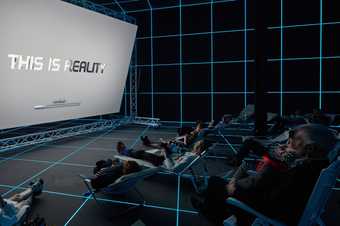How have contemporary artists responded to the new online ecology? What does it mean for online and offline identities as well as the changing value systems of governance? How is the space of the museum being transformed in the age of digital infrastructure?
This course, led by curator and writer Helen Kaplinsky, explores the changing landscape for producing and experiencing art in the age of increasing reliance on the digital. The origins of the internet, early examples of networked structures and artistic experimentation with cybernetics, net.art and new media art will provide an introduction for an overall focus on current tendencies in producing, circulating and experiencing art, bringing about unexpected propositions for reading historical works in the Tate Collection. In conjunction with the course, the Taylor Digital Studio at Tate Britain is hosting Ruth Catlow, artist and co-founder of Furtherfield, in a new research residency. She will take an active part, playing with and challenging the emerging themes and ideas, testing social platforms for their dialogic and participatory potential.
Helen Kaplinsky is an independent curator and writer based in London. She has undertaken fellowships with the Contemporary Art Society and the Arts Council Collection, both of which considered the relationship between property and collections, including work by net.art, New Media and post-internet artists. In recent years she has contributed to programmes at Whitechapel Gallery, South London Gallery, Tate (Britain and Liverpool), The Government Art Collection, ICA (London), The Photographers Gallery (London) and Foundation for Art and Creative Technology (Liverpool). She has programmed with and for project spaces in London key to supporting networked and post-internet practices including Banner Repeater, Arcadia Missa and Lima Zulu.
Course schedule
Week 1 (12 February): Introduction to Network Ideology
In this first session, we look at the origins of digital networks culture: the birth of binary code, cybernetics and the internet. Ruth Catlow, the Digital Learning Artist-in-Residence introduces the live experimental collaboration format to engage with in the six weeks of the course.
Week 2 (19 February): Digital Citizen
How has the digital era transformed the role of the consumer and the labourer? What does the romantic hero of the digital age look like? In this session, we look at the formation of the digital liberal individual and shifts in the notion of identity, categories based on class, race, gender, ethnicity and body politics.
Week 3 (26 February): Digital Landscapes and Infrastructures
What does the material infrastructure of our everyday reliance on the digital look like? How have artists responded to the rise in surveillance, mapping from above and below? We explore these questions by using various tools and techniques, including specialist and everyday software.
Week 4 (4 March): Digital Assets
Through group discussion, we consider how digital assets circulate and gain value, looking at the role that ‘big data’ is playing in these processes. How has the digital asset affected the conception of property? How are artists making use of these shifts? The session is held in the newly installed gallery space at Tate Modern.
Week 5 (11 March): Digital Institutions
This session takes the form of a discussion forum with Tate Curators on the changing landscape of curating, archiving and collecting in the digital age. We share case studies and examples from other contexts in which these questions are of relevance.
Week 6 (18 March): Digital Futures
In this final session, we will look at how the future is imagined by artists, discuss the role of the digital in building the future that we desire, and also decide on the future of the project that we have been working on for the past six weeks

